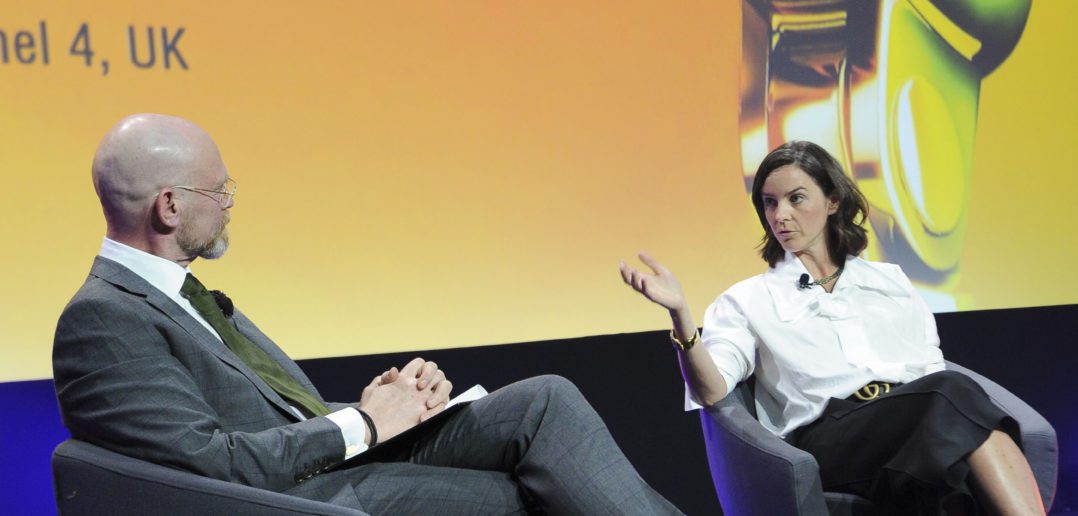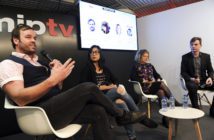MIPTV itself may not start until Monday, but the MIPFormats and MIPDoc conferences got underway today in Cannes, with plenty of views and new formats to think about. Alex Mahon, CEO of UK broadcaster Channel 4, was the keynote speaker on the first day of MIPFormats, in conversation with KLOK non-executive director Gary Carter.
“The television industry has been irrevocably altered by the explosion of the internet,” said Carter by way of introduction, talking about the “desertion of younger audiences” in search of content on new digital platforms. Meanwhile, back on TV big formats are getting bigger, but it has been a while since a new “global super-format” appeared on the scene.
In response, Mahon talked about Channel 4’s history as the “challenger” in British broadcasting, with a remit for creative innovation and provocation. “Everything that we commission is from the independent community,” she noted. “Television has the power to change opinions, attitudes, minds,” she continued, referring to Channel 4’s coverage of the Paralympics, as well as its recent work on the breaking story of Facebook and Cambridge Analytics. “A broadcaster from a relatively small nation can make a big impact.”
What is her vision for Channel 4 over the coming years, and how will she judge its success? “What is our remit? It’s innovation, it’s risk-taking, it’s breaking new talent. It’s representing diversity. The concept of distinctiveness is more important than ever,” said Mahon. “And why are you relevant any more?… What do you provide to the market that others don’t?”
Mahon discussed diversity within the industry. Channel 4 is the most-diverse British broadcaster in terms of ethnicity, but she wants the channel to become even more of a “beacon” for diversity of all kinds.
“Fundamentally, it’s the indicator of commercial success. It’s my belief that to run a creative business, you need to have a room made up of people with different backgrounds and different points of view… and secondly, a culture of honesty so you can discuss things,” she said. “That’s why I’m so interested in diversity, because I think it leads to greater commercial success… If you have creative success, commercial success follows… The bullseye for me is something that’s creatively good and commercially successful.”
 Mahon assessed the impact of technology companies so far on television. “Technology platforms have changed consumers’ relationships. Twitter has changed the length of time of a video or text that a consumer will get involved in. YouTube has changed the quality of production values that people will accept… And Netflix I think has changed the emotional connection… the way people feel about shows,” she said.
Mahon assessed the impact of technology companies so far on television. “Technology platforms have changed consumers’ relationships. Twitter has changed the length of time of a video or text that a consumer will get involved in. YouTube has changed the quality of production values that people will accept… And Netflix I think has changed the emotional connection… the way people feel about shows,” she said.
Mahon went on to talk about big shows getting bigger – The Great British Bake Off being Channel 4’s big example – and event television continuing to be a demand for viewers. “The question for us are what’s the genre mix for that? People are watching a different mix of scripted and unscripted on-demand,” she said.
Has there been not enough creative innovation in the traditional television industry in terms of formats at scale, asked Carter? If The Voice was the last big ‘super-format’ to emerge, why has it not been followed by more?
“There’s a tendency in our industry to de-risk everything… Things crash and burn really fast, or they don’t take off really fast and are abandoned,” said Mahon. Channel 4 wants to open up spaces in its schedule to take those kinds of risks. “And then to encourage the environment where you can be open about things, and try ideas without diluting them by de-risking every element of them. That is the difficult thing.”
Mahon also said that non-scripted television can learn from what’s been happening in the fiction world, where new, distinct voices and ideas have flourished. “The challenge to us on the non-scripted side is how can we come up with formats that are less repetitive, in the form of the talent show and so on, and create pockets for them to live in the schedule?”

The day also saw a panel discussion on how to work with some of the new digital players in the unscripted world: the so-called FAANGS (Facebook, Apple, Amazon, Netflix, Google – i.e. YouTube – and Snapchat). Speakers included Lauren Anderson, chief content officer of NBC and Snapchat parent company Snap, Inc’s joint venture; 25/7 Productions president Dave Broome; Rabbit Films COO and head of international Jonathan Tuovinen; and Vertical Networks CEO Tom Wright. A+E Networks’ head of formats, international programming and production Hayley Babcock moderated.
Wright kicked off. “We’ve gone from a world where because it was a closed-wall kingdom, it was pretty binary: there was success or failure,” he said. “The positive that we take from the way we operate with a partner like Snapchat or Facebook, because you have the data – they’ve got unparalleled audience data. And as a programer for those platforms, they don’t keep that secret from you. You get access to it… So we can optimise and refine based on the learnings we gather.”
Anderson agreed. “The transition from traditional linear to digital – and when you’re talking about Snapchat you’re talking about mobile more than just digital, you’re thinking about the audience so much from the very beginning concept, and having that sort of data available all the time allows you to shape-shift much more quickly than maybe you would in a more traditional linear platform,” she said.
Tuovinen cited Rabbit Films’ Ultimate Expedition, which it made for YouTube Red, the subscription tier of YouTube. “This is an amazing time, and these are incredible opportunities for us. If our US production entity that had never produced a full-length series in the US ever went to an NBC or a CBS and said ‘Hi! Can we produce your biggest non-scripted show ever?’ we probably wouldn’t even get into that room… but for this new type of new client, they have an open mind. They don’t have set rules that they need to apply.”
The panel were asked if they see opportunities for projects that start on a digital platform having a format life that extends back into traditional television. “Not if it’s on Netflix! Because they’re buying the global rights: the rights to the format come off the table,” said Broome. Wright agreed. “Increasingly, everybody is buying global rights,” he said, while noting that Snapchat is bucking that trend, and thus giving producers the opportunity to go on to sell their format globally.
“Perhaps you have to tap in to a different skillset sometimes,” said Anderson. “Obviously if you’re making things that are shorter, you have to be far more efficient with the storytelling. But ultimately we’re focused on premium content, and from that standpoint some of the fundamentals are the same.” Meanwhile Wright suggested that context is everything. “Netflix is as close as you’ve got to a broadcast experience, but if you think about platforms like YouTube, Facebook, Snapchat – social platforms – the context in which your content is going to be served is not something you can ignore or avoid.”
He added that some of the content that isn’t working on those platforms has flopped because it’s been developed by traditional TV producers who haven’t taken the time to understand that context. “It’s about acknowledging that you’re going to need to understand the behaviours before you can programme for these people,” said Wright.
“The belief that there are digital shows and linear/traditional shows, I think, is a little outdated. We want great stuff, we want really amazing things that can live in a number of places,” said Anderson. “For us, you have to sculpt your show for the platform, but the quality of what you’re sending should be great.” And Tuovinen signed off: “Be brave. There are so many opportunities out there… in 2020 this is going to be the new normal, and we’re going to have a whole new set of new platforms and new people who are commissioning content. So don’t get stuck in the old models. Go out there and push your ideas, and push your content.”
 As ever, there were opportunities to hear about hot new formats during the day. That included the first of this MIP’s Fresh TV sessions presented by The WIT CEO Virginia Mouseler (above), focusing on entertainment and game-show pilots. She noted some of the trends in these genres first over the last year: The Wall, This Time Next Year and Little Big Shots are among the most-adapted formats, while in terms of new shows, quiz shows, celebrity formats and physical challenges are all on the rise, while the number of new adventure and dating shows are declining.
As ever, there were opportunities to hear about hot new formats during the day. That included the first of this MIP’s Fresh TV sessions presented by The WIT CEO Virginia Mouseler (above), focusing on entertainment and game-show pilots. She noted some of the trends in these genres first over the last year: The Wall, This Time Next Year and Little Big Shots are among the most-adapted formats, while in terms of new shows, quiz shows, celebrity formats and physical challenges are all on the rise, while the number of new adventure and dating shows are declining.
Among the formats she showed off were: Hardball (distributed by Youngest Media), a game-show where six contestants compete for cash, while being chased by a remorseless metal ball; The Search (Keshet International), which offered a new studio take on word-search games; Ready or Not (Argonon International), which surprises people in the street with quick quizzes and challenges to win cash; Guess the Star (ITV Studios), where celebrities dress up as pop stars and lip-sync, while teams of other celebrities try to guess who’s behind the disguise; and Beat Me If You Can (TNFP), which sees a woman host competing against male celebrities at physical challenges, from kayaking and speed-skating to lumberjacking.
Should I Stay Or Should I Go (The Story Lab) is a singing contest for amateurs, who after going head-to-head have to predict the audience’s vote – and if they think they’ve lost can drop out early to win a cash consolation prize; Buy It Now (All3Media International) has entrepreneurs pitching their product to 100 audience members, and securing bigger orders from the judges if the audience feedback is positive; Fashion Auction (Global Agency) sees participants auctioning off their fashion items, with experts offering their appraisals; Secret Admirer (FremantleMedia) sends people on dates with friends or colleagues who’ve been their secret admirer for years; Love At First Flight (A&E Networks) matches up strangers then sends them round the world for 30 days of travel and romantic challenges before asking them if they want to get married; and In The Car (Pandora Formats) sees five contestants living in a car for 10 days, with the audience voting them out one by one until someone wins the vehicle.
 Today also saw the final of the Formagination at MIPFormats –The International Format Pitch contest, hosted by Armoza Formats and with five new format ideas from around the world. I Need A Hero was pitched by Israeli news anchor and journalist Lital Shemesh. It’s a dating show where men compete in ‘heroic physical challenges’ to impress a single woman – but where in between those feats, she’s secretly testing their character. The Circle! was pitched by David Visnjic of Michael DOLINSEKfilm in Austria. It’s a studio-based quiz show with the contestants on a rotating platform surrounded by 12 screens, trying to play their way out of the circle to take home a cash prize.
Today also saw the final of the Formagination at MIPFormats –The International Format Pitch contest, hosted by Armoza Formats and with five new format ideas from around the world. I Need A Hero was pitched by Israeli news anchor and journalist Lital Shemesh. It’s a dating show where men compete in ‘heroic physical challenges’ to impress a single woman – but where in between those feats, she’s secretly testing their character. The Circle! was pitched by David Visnjic of Michael DOLINSEKfilm in Austria. It’s a studio-based quiz show with the contestants on a rotating platform surrounded by 12 screens, trying to play their way out of the circle to take home a cash prize.
Light My Fire was pitched by Axel Fiacco of BicFormats in Italy. It’s a dating show where contestants wear ‘love shirts’ that light up if they are attracted to a potential partner. They’re then sent on dates to find out ‘if their body was right’. Are You Clueless? was pitched by Spanish producers Isabel Durán and Alfonso Ferrandis. It’s a culture-based game-show that tests people’s knowledge, while also challenging them to admit that they know less than they think. And Future Astronauts was pitched by Miroslaw Skowron of Mediolia in Poland: a show following a group of teenagers getting astronaut training, leading up to a final mission that simulates living on Mars, with cooperative challenges and a positive message for watching viewers.
The overall winner of the contest was Light My Fire, with the judges’ second-place pick going to I Need a Hero. Meanwhile, Future Astronauts took the prize for the audience vote.
 Saturday also saw the kick-off for this year’s MIPDoc conference, with a ‘View From the Top’ session on what kind of documentaries buyers and commissioners are looking for in 2018. The panel included Steve Burns, chief programming officer at CuriosityStream; Christian Drobnyk, EVP of programming strategy and acquisitions at National Geographic Channels; and Thierry Mino, deputy head of documentaries, international coproductions and acquisitions at France 5. The moderator was Anna Carugati-Guise, group editorial director at World Screen.
Saturday also saw the kick-off for this year’s MIPDoc conference, with a ‘View From the Top’ session on what kind of documentaries buyers and commissioners are looking for in 2018. The panel included Steve Burns, chief programming officer at CuriosityStream; Christian Drobnyk, EVP of programming strategy and acquisitions at National Geographic Channels; and Thierry Mino, deputy head of documentaries, international coproductions and acquisitions at France 5. The moderator was Anna Carugati-Guise, group editorial director at World Screen.
Among the talking points: Mino giving a public-service broadcaster’s perspective on factual. “Sometimes, the ambitions, the angles, the explanations that the public can expect to find are in the public channels,” he said. “When we are doing shows about violence against women or women living on the streets, what we want to explain, to introduce to the audience will be completely different from what a private company would do. The angles would be different.”
Burns explained what kind of audience that CuriosityStream is drawing to its on-demand documentaries subscription service. “Our subscriber base is 34% millennial, which in our former TV worlds is pretty remarkable. And 40% of all the people who come to us are either cord-nevers or cord-cutters. These are people who TV can’t reach, for the most part… They’re craving science and history,” he said.
As for what the commissioners are looking for, Mino said science, space, ancient civilisations and archeology are currently doing well for France 5, while it’s also looking for discovery and wildlife acquisitions for daytime slots. Burns, meanwhile, warned of the importance of finding new ways to cover familiar topics.
“We’re always looking for a new production technique that allows people to revisit those topics. And science is always changing, so that’s something great: we can continue science indefinitely. It’s that substance matched with a very entertaining storytelling style that we’re looking for,” said Burns.
Drobnyk addressed a question about whether there’s enough content to sate the appetites of the big linear channels and VOD services. “There’s enough content. I think there was a period when there was a big creative crisis, frankly, in non-fiction television. And reality television took us there,” he said. But this crisis has eased, he suggested. Burns agreed: “When all networks went to reality, the people who normally came to Discovery and National Geographic for history and science could no longer find it. We’re getting a lot of those people coming to us now,” added Burns.
All the commissioners are looking for a balance between series and one-off specials, although Burns suggested that a digital service has more need to provide variety for its subscribers through specials, rather than blowing most of its budget on just a few series. All are also focused on ensuring younger viewers find their way to documentaries. “Making the content relevant to a new generation of viewers. That’s really the key, because ultimately it’s about the content,” said Drobnyk.
Burns noted the competition in the online-video space, with an estimated 900 SVOD services worldwide. “Only a handful have factual programming like we do, so that reduces the competition,” he said, before citing another problem that’s on his mind: “The rights issues. A broadcaster that originates a film, naturally they’re going to want to maximise the broadcast of that programme in their own market, so we have to geo-block here and there around the world,” he said.
 The panel ended with Drobnyk, Mino and Burns being presented with World Screen Factual Trendsetter awards by Carugati-Guise and Reed Midem’s Laurine Garaude (above).
The panel ended with Drobnyk, Mino and Burns being presented with World Screen Factual Trendsetter awards by Carugati-Guise and Reed Midem’s Laurine Garaude (above).
Later in the day there was also a MIPDoc keynote superpanel, exploring the power shift of ‘distributors as content kickstarters’, where distributors have been increasingly playing a role more akin to commissioners. Panelists included Solange Attwood, EVP international at Blue Ant Media; Isabelle Graziadey, executive director of international sales and acquisitions at Terranoa; and Cristine Platt Dewey, managing director of ro*co films international. The moderator was Pauline Mazenod, head of film acquisitions and sales at Windrose.
“When the creative and financial sides come together you get strong navigation of the market earlier on. You can craft your film to the market, and can think outside of your local domestic market with help from international distributors,” said Graziadey. Meanwhile, Attwood mentioned the changing responsibilities for distributors. “The need to provide market intelligence is becoming more important,” she said. “OTT brings more buyers and more opportunities, whether that’s in traditional licensing or in structuring co-productions and pre-sales.”
Dewey suggested that this is often more about bringing market expertise, rather than necessarily creative input. “We can be a resource in understanding what the market realities are, and understanding where a project might match and ultimately go. The other piece is putting financing together – relationships with US broadcasters and private funders in the US,” she said, before addressing the issue of platforms like Netflix taking global rights. “It has evolved to a point where often the global deals don’t allow us to be international distributors, so now we’re becoming global sales agents for our projects – and when you do that you have to get involved earlier. We’ve always said get international distribution expertise earlier.”
.@NHK’s breathtaking 4K aerial documentary Japan from Above’s #MIPDoc World Premiere TV Screening is starting now! Fox Networks/Voyage’s Marika Puiseux, ZDF/Arte’s Marita Hübinger, NHK’s Sayumi Horie and Gedeon Programmmes’ Stéphane Milliere present pic.twitter.com/IqQ2ruNznJ
— MIP Markets (@mip) April 7, 2018
MIPDoc closed with a World Premiere TV Screening of NHK’s Japan From Above, which offers an aerial view of Japan at 4K resolution. “I’ve never seen such amazing images from Japan!” said ZDF/Arte’s Marita Hübinger as the show was introduced. You can get a taster from the trailer below:




